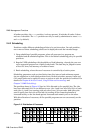
RMS Management Functions
2.4 RMS Management Functions
The RMS gives the system administrator control over how the resources of a system are
assigned to the tasks it must perform. This includes the allocation of resources
(Section 2.4.1), scheduling policies (Section 2.4.2), access controls and accounting
(Section 2.4.3) and system configuration (Section 2.4.4).
2.4.1 Allocating Resources
The nodes in an RMS system can be configured into mutually exclusive sets known as
partitions as shown in Figure 2.4. The administrator can create partitions with different
mixes of resources to support a range of uses. For example, a system may have to cater
for a variety of processing loads, including the following:
• Interactive login sessions for conventional UNIX processes
• Parallel program development
• Production execution of parallel programs
• Distributed system services, such as database or file system servers, used by
conventional UNIX processes
• Sequential batch streams
Figure 2.4: Partitioning a System
Login
Sequential
batch
Parallel
The system administrator can allocate a partition with appropriate resources for each of
these tasks. Furthermore, the administrator can control who accesses the partitions (by
user or by project) and how much of the resource they can consume. This ensures that
resources intended for a particular purpose, for example, running production parallel
codes, are not diverted to other uses, for example, running user shells.
Overview of RMS 2-7


















